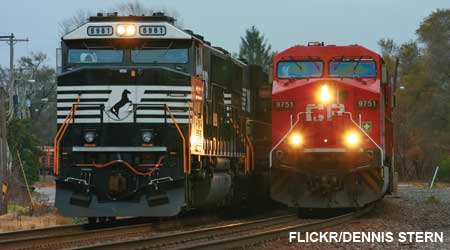Stay updated on news, articles and information for the rail industry
July 2025
Rail News: Rail Industry
Rails and M&A: TEMP's rising and are we 'Burning Down the House'? — by Tony Hatch

It's been hard to concentrate of late with all the noise about M&A. I guess that's just how it is in this life during wartime.
What are my thoughts? Given the explosion of arb/investor/banker calls, I reluctantly raise my (completely unscientific) Transcon Estimated Model Probability (%) or "TEMP" from 0> and <5% to ... low double digits? 10%> to <25%?
So, let's say the TEMP today is +/- 20%. Do we want to burn down the house?
This increase in TEMP is not because of anything specific coming from the rails (our RailTrends 2025 Railroad Innovator Award recipient Jim Vena perhaps excepted), or the regulators, or even the fanboy observers. It’s been rising thanks to the activity and interest of the financial community, the first stakeholder among equals. Strange as it seems, they just might not have the best long-term interests of the railroad industry in mind.
I have been in close contact with C-suite execs at almost every Class I, as well as regulators and other stakeholders from shipper and supplier meetings across the country. To a person they say: “Wouldn't it be nice? But it's not worth the risk.”
So, for reals, what, if anything, has changed?
How did we get here?
After all, didn't the rejection of the BNSF-CN at the turn of the century, and the interpretation of the new and old rules in deciding for CPKC (and not CNKC) mean the former was the "last rail merger"? I certainly thought so, and checking those odds, I still do (though if I'm wrong ...). But at RailTrends 2024, Adriene Bailey of Oliver Wyman, the consulting thought-leader for the industry, spoke about the need for the industry to grow as the returns from further efficiency (see "OR, Cult of") gains were diminishing. And, she saw growth opportunities in industrial development, short-line partnerships and intermodal — all three of which have indeed had more "wins" in '25.
The rails, at RT24, and in investor days and quarterly calls since, all have outlined their (pivot to) growth agendas, in fact.
But to date, the rails haven't demonstrated consistent, large-scale success. Sure, there's been a once-in-a century pandemic; a freak accident; two trade wars etc. But if the rails cannot or will not grow, Adriene argued last November, they face two choices: in essence, shrink to regulated commodities and share resources (and, in my mind, become utility-like dividend plays) or merge into two transcons. The latter would:
• improve OR by 125-250bps;
• eliminate ~$140mm in SG&A (10%); and
• improve service through eliminating interchange frictions and providing a single source for contact (at the risk of eliminating some route optionality).
Many sell-siders and investors were in the audience at RT24 and saw either truth (remember, the speech was really an encouragement to grow, not buy) or opportunity — and that speech has been repeated by OW since. The observer class got on board, UP talked it up and we were off to the races.
Now, we're at the rumor phase, with industry players being questioned by some folks who may be "talking their book", and lawyers, consultants, network experts being snapped up like Hollywood divorce lawyers. I may not need him or her, but, darn it, they can't have 'em! So, now, everybody's in a tizzy!
Why now??
The reasoning: Remember the three (supposed) triggers:
• Two CEOs aren't "career railroaders" and NO CEO save Ms. Farmer has historic DNA or long ties to the company they lead (supposedly making them more deal "friendly. Several CEOs objected to this stating believably that they would always uphold their fiduciary duty).
• The lack of growth (volume, share, market cap).
• The new administration would be laissez-faire to the max (and I am not so sure about that — see Google, for instance). As one true first-ballot rail HoFer told me, DC has "a fairly large amount of populism embedded in their thinking." On the other hand, the recent approval of a $35B chip deal used "remedies" to counter deal objections (for rails, that could be haulage rights, etc). So, who the heck knows? But government approval at minimum is no sure thing.
Surface Transportation Board Chairman Patrick Fuchs is (unfortunately for me) terrific at keeping his own counsel, asking pointed questions but revealing very, very little. Some deal-oriented folks have taken Fuch's speech about improving STB rulemaking throughput and efficiency to mean a coded approval of a fast transcon review (arbs don't like to see their money tied up too long, of course). That belief is wishful thinking.
The key phrase is "enhanced competition," the "new rule" that sank one Canadian bid (CN) compared with another (CP). It is undefined, a version of MAD — Mutually Assured Destruction. If it were to be defined, thereby creating something to model against and a problem to solve, then a ratcheting up of the TEMP scale — perhaps to boiling — would ensue.
Here’s another analogy: Wow about The Great War (WWI)? The "Guns of August" fired after no nation wanted to start a war, but were worried about the actions of rivals. All armies were put on alert and tensions mounted; then the archduke went to Sarajevo, and the car went down the wrong street, and the match was lit ... “Burning Down The House!” Who could play the assassin Princip here? Activists? Bankers? One ambitious CEO?
The opportunity
These are intuitively obvious, if ill-defined. The biggest anticipated benefit would come, as it has with CPKC, with single-line service. "Interline" goes away, the issue of whether to interline in Chicago as a hub or, say St Louis (some 300 miles farther west, or in a western rail territory and thus a revenue mile disadvantage) goes away. No more "24 hours" in Chicago, rubber-tiring from one rail to another through traffic (etc., etc.) There would be crew changes, but no more difficult carrier changes.
What would those service improvements yield? And: How much do they exist today in premium intermodal? Can't rails actually partner, given the huge advances in IT/AI and cooperation?
In talking to a variety of serious thinkers on the topic, more advantages emerged:
• The issue of being a regional carrier in a continental or even global supply chain world would be eliminated -- national accounts would ensue, and product/geographic competition, unrecognized by the STB but, in fact, existing (see Justice Potter on pornography), would go away; you could, as one thought-leader told me, move away from TPC towards true route planning.
• The SG&A savings.
• Single product development in IT, as opposed to the historic model of each railway going on alone; the battle for cooperation (RailPulse etc.) would also be moot.
• Redeployment of mid-continent yard/terminal assets and related capex.
• Single sources for capex decisions (a big point to the late, great Pat Ottensmeyer in discussing CPKC).
• The Watershed opportunity! That's the business a short haul on either side of the Mississippi that no rails want to cooperate to get (and what short lines do every day). How big is it? No one knows, or — strangely — will say. How much of that business (say, Iowa white goods manufacturing) went to Mexico?
• The skeptic's position is close to consensus: Railroads can't grow, partnerships never work, rails have even commissioned studies to convert rail right of way to private freight roadways, etc., etc. — so what else can they do?
• CPKC has surely been a financial if not (yet) a volume success (improved LOH, economic synergies, pricing), and these will also be end-to-end (possibly?), without labor objections and relatively "simple", save, maybe, for IT cutovers.
The risk
The risk is, of course, the unknown. For every Drake who risked it all by sailing out to uncharted seas (and maybe off the end of the world), there were plenty whose boats sank like stones. Is it worth it for 125-250bps of margin? That seems like "pretty small beer" to me! That aforementioned HoFer also told me: “I don’t think any transaction goes through without deep structural changes," which I interpret to mean open access among other scary potentialities. Another strategic thinker thought it would be "death by 1000 cuts" rather than one big blow, but the risk of the blow is immense. Who'd build a BIG for everyone's use? And, by the way, are some of the rail negotiations over Amtrak access setting the stage for further exploration of access even before the house fire??
More thoughts on the downside:
• Retired BNSF CEO Matt Rose, an early supporter of the transcon merger, said many times on his sold-out 2019 "Last Dance" Retirement Tour of the USA that such mergers would only occur if shippers wanted them to — and that would only happen if the rails ran out of capacity and need those interline hours. That is not the case now, of course. We are in a position of over-capacity.
• Giant, powerful shipper companies that had heretofore avoided rail regulatory or merger issues in DC — they had bigger fish to fry — would find the transcon a big enough fish. Companies like Walmart, Amazon, UPS, etc., etc.
• Rail mergers essentially open the book on rail practices — possibly anything goes, and everyone wants their pound of flesh.
• How big is that watershed business, anyway? And isn’t there a low-risk way to attack that opportunity, the use of short lines as UP is doing for FMLM in Oregon and KC?
Other thoughts
One is: Where is Canada in all of this? Those two carriers have strong, independent franchises, but how do they fare as the "Big Four" might become the "Tremendous Two"? In this day and age, the requirement for CN to be headquartered in Montreal is not to be taken lightly (and how would that play in Mar-A-Lago??). Can they do anything about it? Not likely; their exclusion (and Mexico) is a sign o' the times, politically.
A few more thoughts:
• My belief is that the pairings would be UP-CSX (chemicals) and BNSF-NS (intermodal). But many students of transcon (and this has been studied ad nauseum for decades) say that, in truth, there isn't a real marked difference between the pairings ... which belies the first-mover advantage and reduces, greatly, the likelihood of a bidding war a la CN vs CP for KCS).
• It is widely thought that rails cannot go hostile; that is, Railroad A can't make a public bid for Railroad B because if the unwilling target goes into the regulatory process in an uncooperative manner, a deal wouldn't pass.
• Those points reduce, but hardly eliminate, the risk that an outside financial spark (say, from the smoking gun of an arb or an activist) would ignite the fire.
• A real risk is investor/analyst over-optimism, based on deal (or fee) fever — which I have seen in the numerous calls received, and from what I have read — for example, blithe disregard for the open-access risk a solution that "may not be warranted" (may?!?); that earlier mergers share a cost story as this potential one might; that "no merger in railroad history has led to elimination of meaningful customer choice" (I agree in principle ... after all, the highway exists ... but practically, I would refer that analyst to the ACC or to see how BNSF and UP have opted away from Laredo, etc., etc.). Finally, the assumptions of the percentage of interline traffic (thus the benefits of its elimination) seem to consistently be overstated for the simple reason of not removing Class I/short-line services, a large and growing portion.
• More than one strategist/observer said a transcon move might be beneficial if left unchallenged or modified, but it would represent a rather demoralizing admission of failure in cooperation, focus, technology, etc. Who wants to admit that?
• Under the current circumstances, I wouldn't venture to risk all that effort and time, counter all of the work in building partnerships and preparing for the market turn, possibly getting a more-regulated open-access system as a reward — all for 125-250bps?!?
Tony Hatch is an independent transportation analyst and consultant, and program consultant for Progressive Railroading’s RailTrends® conference. Email him at anthonybhatch@gmail.com.


 CPKC’s Invigorated Industrial Development Strategy
CPKC’s Invigorated Industrial Development Strategy
 Introducing The Rising Stars Of 2025
Introducing The Rising Stars Of 2025
 Richard Kloster On The Rail-Car Supply Chain’s Future
Richard Kloster On The Rail-Car Supply Chain’s Future
 Sizing Up Winter MOW Equipment In Summer
Sizing Up Winter MOW Equipment In Summer
 railPrime
railPrime







